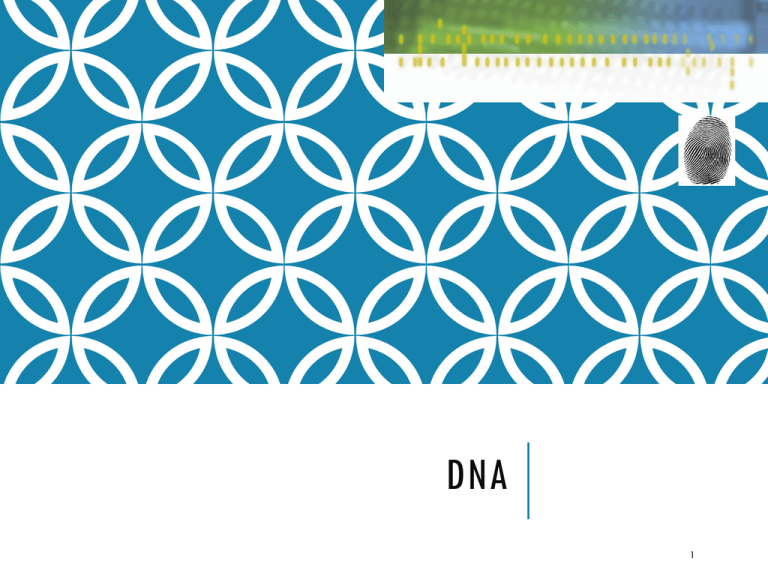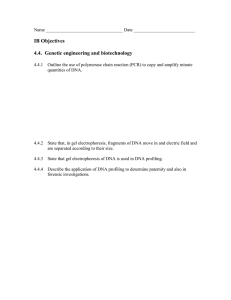DNA 1
advertisement

DNA 1 DNA Actually, a human cell contains two types of DNAnuclear and mitochondrial. We will focus first on nuclear DNA. Nuclear DNA strand is a very large molecule made by linking a series of repeating units called nucleotides. FORENSIC SCIENCE: FUNDAMENTALS & INVESTIGATIONS, CHAPTER 7 3 HISTORY OF BIOLOGICAL EVIDENCE IN FORENSICS DNA fingerprinting Also known as DNA profiling Used with a high degree of accuracy Biological evidence is examined for the presence of inherited traits Some forensics laboratory techniques were originally developed for other purposes. Can you name any? FORENSIC SCIENCE: FUNDAMENTALS & INVESTIGATIONS, CHAPTER 7 4 HEREDITY AND PATERNITY Paternity testing has historically involved the A-B-O blood typing system, along with blood factors other than A-B-O. Currently, paternity testing has implemented DNA test procedures that can raise the odds of establishing paternity beyond 99 percent. FORENSIC SCIENCE: FUNDAMENTALS & INVESTIGATIONS, CHAPTER 7 5 THE FUNCTION AND STRUCTURE OF DNA DNA contains the genetic material of a cell Chromosomes are located in the cell nucleus Chromosomes contain long DNA strands wrapped around proteins FORENSIC SCIENCE: FUNDAMENTALS & INVESTIGATIONS, CHAPTER 7 6 THE FUNCTION AND STRUCTURE OF DNA Nitrogenous Bases—pairs of molecules that form the rungs of the DNA “ladder” Four types of Bases A (adenine) C (cytosine) G (guanine) T (thymine) FORENSIC SCIENCE: FUNDAMENTALS & INVESTIGATIONS, CHAPTER 7 7 NUCLEOTIDES FORENSIC SCIENCE: FUNDAMENTALS & INVESTIGATIONS, CHAPTER 7 8 THE FUNCTION AND STRUCTURE OF DNA Base-Pairing Rules adenine (A) binds only with thymine(T) Cytosine (C) binds only with guanine (G) FORENSIC SCIENCE: FUNDAMENTALS & INVESTIGATIONS, CHAPTER 7 9 BASE PAIRING LEADS TO DOUBLE HELIX FORENSIC SCIENCE: FUNDAMENTALS & INVESTIGATIONS, CHAPTER 7 10 DNA AT WORK DNA directs the production of proteins, which are made by combining amino acids. Each group of three nucleotides in a DNA sequence codes for a particular amino acid. Example: G-A-G codes for the amino acid glutamine, while C-G-T codes for alanine. FORENSIC SCIENCE: FUNDAMENTALS & INVESTIGATIONS, CHAPTER 7 11 IMPORTANCE OF BASE PAIRS FORENSIC SCIENCE: FUNDAMENTALS & INVESTIGATIONS, CHAPTER 7 12 DNA REPLICATION DNA duplicates itself prior to cell division. DNA replication begins with the unwinding of the DNA strands of the double helix. Each strand is now exposed to a collection of free nucleotides that will be used to recreate the double helix, letter by letter, using base pairing. FORENSIC SCIENCE: FUNDAMENTALS & INVESTIGATIONS, CHAPTER 7 13 REPLICATION FORENSIC SCIENCE: FUNDAMENTALS & INVESTIGATIONS, CHAPTER 7 14 DNA IDENTIFICATION Polymorphisms: Non-coded DNA that contain unique patterns of repeated base sequences that that are unique to individuals DNA Fingerprinting (Profiling) isolates and analyzes polymorphisms DNA fingerprints appear as a pattern of bands on Xray film. FORENSIC SCIENCE: FUNDAMENTALS & INVESTIGATIONS, CHAPTER 7 15 DNA PROFILE Two types of repeating DNA sequences Variable Numbers of Tandem Repeats (VNTR) The number of repeats varies from person to person 9 to 80 bases in length Short Tandem Repeats (STR) 2 to 5 bases in length Shorter lengths make STRs easier to use than VNTRs VNTR and STR data are analyzed for tissue matching inheritance matching FORENSIC SCIENCE: FUNDAMENTALS & INVESTIGATIONS, CHAPTER 7 16 POLYMERASE CHAIN REACTION (PCR) TESTING Polymerase chain reaction (PCR) is a technique for replicating small quantities of DNA or broken pieces of DNA found at a crime scene, outside a living cell. FORENSIC SCIENCE: FUNDAMENTALS & INVESTIGATIONS, CHAPTER 7 17 PCR 1. First, the DNA is heated to separate it. 2. Second, primers (short strands of DNA used to target specific regions of DNA for replication) are added, which hybridize with the strands. 3. Third, DNA polymerase and free nucleotides (A, T, G, and C) are added to rebuild each of the separated strands. 4. Now, this cycle is repeated 25 to 30 times. Within a few hours a short strand of DNA can be multiplied a billionfold. FORENSIC SCIENCE: FUNDAMENTALS & INVESTIGATIONS, CHAPTER 7 18 Appropriate primers are positioned close to the repeat units of a DNA segment in order to initiate the PCR process that will create short or mini STRs. FORENSIC SCIENCE: FUNDAMENTALS & INVESTIGATIONS, CHAPTER 7 19 STR STRs are locations on the chromosome that contain short tandem repeats that repeat themselves within the DNA molecule. STRs normally consist of repeating sequences of 3 to 7 bases in length, and the entire strand of an STR is also very short, less than 450 bases in length. FORENSIC SCIENCE: FUNDAMENTALS & INVESTIGATIONS, CHAPTER 7 20 POWER OF STR What makes STRs so attractive to forensic scientists is that hundreds of different types of STRs are found in human genes. The more STRs one can characterize, the smaller will be the percentage of the population from which a particular combination of STRs can emanate. Can be achieved via multiplexing FORENSIC SCIENCE: FUNDAMENTALS & INVESTIGATIONS, CHAPTER 7 21 FORENSIC SCIENCE: FUNDAMENTALS & INVESTIGATIONS, CHAPTER 7 22 RFLP Restriction Fragment Length Polymorphisms (RFLP) RFLPs are length differences associated with relatively long repeating DNA strands and form the basis for one of the first DNA typing procedures. FORENSIC SCIENCE: FUNDAMENTALS & INVESTIGATIONS, CHAPTER 7 23 DNA PROFILE MATCHING Tissue Matching Two samples that have the same band pattern are from the same person Inheritance Matching Each band in a child’s NDA fingerprint must be present in at least one parent FORENSIC SCIENCE: FUNDAMENTALS & INVESTIGATIONS, CHAPTER 7 24 DNA POPULATION DATABASES Population genetics: the study of gene variations among groups of individuals Analyze the probability of a random person with the same alternative form of a gene (an allele) Examples Identifying the suspect in a crime Identifying an alleged father in a paternity case FORENSIC SCIENCE: FUNDAMENTALS & INVESTIGATIONS, CHAPTER 7 25 PRODUCT RULE A high degree of discrimination and even individualization can be attained by analyzing a combination of STRs (multiplexing). Because STRs occur independently of each other, the probability of biological evidence having a particular combination of STR types is determined by the product of their frequency of occurrence in a population. FORENSIC SCIENCE: FUNDAMENTALS & INVESTIGATIONS, CHAPTER 7 26 SEX DETERMINATION BY STR The amelogenin gene, which is actually the gene for tooth pulp, is shorter by six bases in the X chromosome than in the Y chromosome. FORENSIC SCIENCE: FUNDAMENTALS & INVESTIGATIONS, CHAPTER 7 27 MITACHONDRIAL DNA Mitochondrial DNA (mtDNA) is located outside the cell’s nucleus and is inherited from the mother. Mitochondria are structures found in all our cells used to provide energy that our bodies need to function. FORENSIC SCIENCE: FUNDAMENTALS & INVESTIGATIONS, CHAPTER 7 28 CODIS CODIS (Combined DNA Index System) is a computer software program developed by the FBI that maintains local, state, and national databases of DNA profiles from convicted offenders, unsolved crime scene evidence, and profiles of missing persons. It currently contains about 470,000 profiles from unsolved cases. FORENSIC SCIENCE: FUNDAMENTALS & INVESTIGATIONS, CHAPTER 7 29 SOURCES OF DNA Biological evidence: examples include saliva, blood, skin, hair, seminal fluid Individual evidence is capable of identifying a specific person. Small amounts may be only trace evidence Polymerase chain reaction (PCR) technique generates multiple copies of DNA evidence FORENSIC SCIENCE: FUNDAMENTALS & INVESTIGATIONS, CHAPTER 7 30 COLLECTION AND PRESERVATION OF DNA 1. Use disposable gloves and collection instruments 2. Avoid physical contact, talking, sneezing, and coughing in the evidence area 3. Air-dry evidence and put it into new paper bags or envelopes 4. Dry or freeze the evidence 5. Keep evidence cool and dry during transportation and storage FORENSIC SCIENCE: FUNDAMENTALS & INVESTIGATIONS, CHAPTER 7 31 PREPARING DNA SAMPLES FOR FINGERPRINTING 1. 2. 3. 4. DNA is mixed with special enzymes Enzymes cut apart the DNA in specific places forming different sized fragments DNA is separated within an agarose gel An electric current is passed through the gel separating the fragments by size FORENSIC SCIENCE: FUNDAMENTALS & INVESTIGATIONS, CHAPTER 7 32 PREPARING DNA SAMPLES FOR FINGERPRINTING Extraction 1. Cells are isolated from biological evidence such as blood, saliva, urine, semen, and hair 2. The cells are disrupted to release the DNA from proteins and other cell components 3. The DNA can be extracted from the cell nucleus FORENSIC SCIENCE: FUNDAMENTALS & INVESTIGATIONS, CHAPTER 7 33 PREPARING DNA SAMPLES FOR FINGERPRINTING Amplification VNTR analyses—polymerase chain reaction (PCR) can be used to amplify the DNA that contains the VNTRs STR profiles—restriction enzymes are unnecessary; PCR allows the amplification of the strands with STR sequences FORENSIC SCIENCE: FUNDAMENTALS & INVESTIGATIONS, CHAPTER 7 34 PREPARING DNA SAMPLES FOR FINGERPRINTING Electrophoresis DNA samples are placed in gels through which electronic currents are passed DNA fragments line up in bands along the length of each gel FORENSIC SCIENCE: FUNDAMENTALS & INVESTIGATIONS, CHAPTER 7 35 ELECTROPHORESIS An electrophoresis apparatus running five sample of DNA Arrows show the movement of the negatively charged DNA fragments through the gel matrix FORENSIC SCIENCE: FUNDAMENTALS & INVESTIGATIONS, CHAPTER 7 36 PROBES DNA probes identify the unique sequences in a person’s DNA are made up of different synthetic sequences of DNA bases complimentary to the DNA strand bind to complimentary bases in the strand (see the fragmentary DNA bands above) In most criminal cases, 6 to 8 probes are used FORENSIC SCIENCE: FUNDAMENTALS & INVESTIGATIONS, CHAPTER 7 37 ANALYSIS OF DNA FINGERPRINTS AND APPLICATIONS Bands and widths are significant in matching samples of DNA FORENSIC SCIENCE: FUNDAMENTALS & INVESTIGATIONS, CHAPTER 7 38 ANALYSIS OF DNA FINGERPRINTS AND APPLICATIONS DNA fingerprinting can match crime scene DNA with a suspect determine maternity, paternity, or match to another relative eliminate a suspect free a falsely imprisoned individual identify human remains FORENSIC SCIENCE: FUNDAMENTALS & INVESTIGATIONS, CHAPTER 7 39 . . . . . . . . . . . . . . SUMMARY . . . . DNA contains the information needed for replication in a sequence of nitrogenous bases. DNA analysis allows even a small sample of tissue to be identified with a single individual. DNA contains, in non-coding regions called junk DNA, many repeated sequences that vary in number between individuals. These differences between individuals can be used to produce a DNA fingerprint for an individual. FORENSIC SCIENCE: FUNDAMENTALS & INVESTIGATIONS, CHAPTER 7 40 . . . . . . . . . . . . . . . . . SUMMARY Polymerase chain reaction (PCR) for DNA amplification has largely eliminated the problem resulting from the tiny samples usually available. DNA evidence must be collected carefully to avoid contamination with other DNA. DNA analysis involves extraction, electrophoresis, and visualization. DNA profiles are kept by police agencies in electronic databases. FORENSIC SCIENCE: FUNDAMENTALS & INVESTIGATIONS, CHAPTER 7 41


